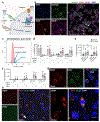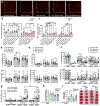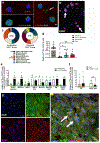B cells upregulate NMDARs, respond to extracellular glutamate, and express mature BDNF to protect the brain from ischemic injury
- PMID: 39900302
- PMCID: PMC11948303
- DOI: 10.1016/j.nbd.2025.106819
B cells upregulate NMDARs, respond to extracellular glutamate, and express mature BDNF to protect the brain from ischemic injury
Abstract
Following stroke, B cells enter brain regions outside of the ischemic injury to mediate functional recovery. Although B cells produce neurotrophins that support remote plasticity, including brain-derived neurotrophic factor (BDNF), it remains unclear which signal(s) activate B cells in the absence of infarct-localized pro-inflammatory cues. Activation of N-methyl-d-aspartate (NMDA)-type receptor (NMDAR) subunits on neurons can upregulate mature BDNF (mBDNF) production from a pro-BDNF precursor, but whether this occurs in B cells is unknown. We identified GluN2A and GluN2B NMDAR subunits on B cells that respond to glutamate and mediate nearly half of the glutamate-induced Ca2+ responses in activated B cell subsets. Ischemic stroke recruits GluN2A+ B cells into the ipsilesional hemisphere and both stroke and neurophysiologic levels of glutamate regulate gene and surface expression. Regardless of injury, pro-BDNF+ B cells localize to spleen/circulation whereas mBDNF+ B cells localize to the brain, including in aged male and female mice. We confirmed B cell-derived BDNF was required for in vitro and in vivo B cell-mediated neuroprotection. Lastly, GluN2A, GluN2B, glutamate-induced Ca2+ responses, and BDNF expression were all clinically confirmed in B cells from healthy donors, with BDNF+ B cells present in post-stroke human parenchyma. These data suggest that B cells express functional NMDARs that respond to glutamate, enhance NMDAR signaling with activation, and upregulate mature BDNF expression within the brain. This study identifies potential glutamate-induced neurotrophic roles for B cells in the brain; an immune response to neurotransmitters unique from established pro-inflammatory stimuli and relevant to any CNS-localized injury or disease.
Keywords: B lymphocytes; Brain-derived neurotrophic factor; Cerebral ischemia; GluN2A; GluN2B; IL-10; Neuroprotection.
Copyright © 2025 The Authors. Published by Elsevier Inc. All rights reserved.
Conflict of interest statement
Declaration of competing interest The authors declare that they have no known competing financial interests or personal relationships that could have appeared to influence the work reported in this paper.
Figures





References
-
- Baba Y, Kurosaki T, 2016. Role of calcium signaling in B cell activation and biology. Curr. Top. Microbiol. Immunol 393, 143–174. - PubMed
-
- Barouch R, Appel E, Kazimirsky G, Braun A, Renz H, Brodie C, 2000. Differential regulation of neurotrophin expression by mitogens and neurotransmitters in mouse lymphocytes. J. Neuroimmunol 103 (2), 112–121. - PubMed
Publication types
MeSH terms
Substances
Grants and funding
LinkOut - more resources
Full Text Sources
Miscellaneous

